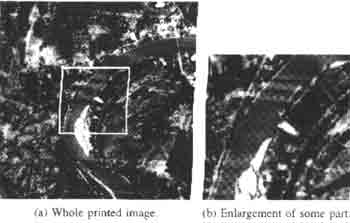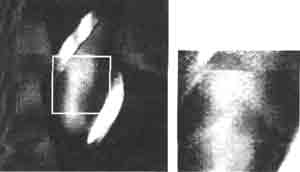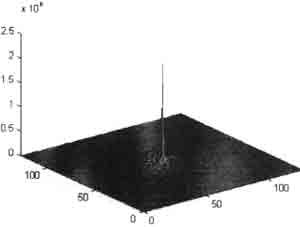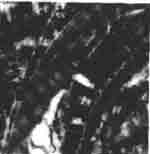| GISdevelopment.net ---> AARS ---> ACRS 1995 ---> Poster Session 4 |
Digital Image Data Recovery
from Printed Image
F. Cheevasuvit*, K.
Dejhan*, V.Tipsuwanporn*, and A. Somboonkaew**
*Faculty of Engineering, king Mongkut's Institute of Technology Ladkrabang,
Bangkok 10520, Thailand.
** Mahanakorn University of Technology, Bangkok 10530, Thailand.
Abstract *Faculty of Engineering, king Mongkut's Institute of Technology Ladkrabang,
Bangkok 10520, Thailand.
** Mahanakorn University of Technology, Bangkok 10530, Thailand.
Sometime, the raw data of selected image cannot be provided by the producer. Therefore the digital image data must be reproduced form the available information especially printed image. To accomplish this task, a scanning device is used. However, for the printing reason, some undesired texture is appeared in the printed image. This kind of texture will result a specified Fourier spectrum, so it can be removed by using filter function in the frequency domain. Hence, the digital data of desired image scene is recovered.
1. introduction
Nowadays. the advances in technology of electronics cause the decrement in price of personal computer (PC) and also the scanning device. Accordingly, the small organizations can purchase by their own budget, especially the remote local department such as forestry department, irrigation department and agriculture department etc. All these remote local organizations. Sometime they want to process a new data of selected satellite image and seemingly the producer cannot provide the data to the requested organization in time. However, if the remote organization already has a selected satellite image in hand but in another form such as printed image on paper. The satellite data can be reproduced in digital data form by using a scanning device and PC of the organization. However, for the printing reason, some undesired texture will be presented in the printed image. This kind of texture have a specified Fourier spectrum, and it can be eliminated by using some kind of filter function which will described in the following paragraph.
2. Reproduction of digital image data from printed image
To response the immediately desired to use of a digital satellite data from an available printed image, a scanning device and PC are used. The interested image is scanned by using some solfware program to converse the printed image in to the digital image data and store in the PC memory. Nevertheless, for some printing reason, it will appear an undesired texture which can be shown as an instance in Fig. 1 and 2. Fig. 1 (a) and 2 (a) are some printed images. While the Fig. 1 (b) and 2(b) are some part of images which are enlarged to show clearly the existence of texture.

Figure 1 Printed image of satellite data

Figure 2 Printed image of drilling machine
The undesired texture is distributed over the whole image with the same structure which is considered as periodic noise. This periodic noise be unable to exclude by simple template matching method [1]. Anyway this kind of noise can be eliminate by using filter function in frequency domain. Fourier transform is applied to the noise image in order to obtain the spectrum of the interested image. The center of the Fourier transform array is the average brightness value. The spectrum away from the center depicts the proportion of increasing spatial frequency component. Generally the spectrum of undesired texture will be located in the high frequency portion. Hence, the filter is applied to eliminate the high frequency spectrum corresponded to the undesired texture. consequently, the digital data of interested image is obtained.
3. Experimental and result
The image Fig. 1(a) is obtain by scanning the printed image and store in the memory PC. Enlargement a part of Fig. 1(a) is shown in Fig.1(b). It is cleared that there exists some undesired texture in the scanned image. Hence, to reproduce a complete digital image, this kind of texture must be removed. Here, the Fourier transform is applied to the scanned image obtain its spectrum which is shown in Fig. 3. The undesired texture or periodic noise is easy found in high frequency portion of the spectrum. A filter function of Fig. 4, which defined certain bands for rejecting the specified frequencies of undesired texture, is applied to the image spectrum. The filtered spectrum is shown in Fig. 5. The resulting image shown in Fig.6 is achieved by Appling inverse Fourier transform to the spectrum of Fig. 5. The Fig. 6 shows the periodic noise free image.

Figure 3 Spectrum of image in Fig. 1(a) obtained by using transform

Figure 4 Specified filter function to remove the spectrum of undesired texture is high frequency portion

Figure 5 Filtered spectrum

Figure 6 Resultant of digital image data obtained by the inverse Fourier transform of filtered spectrum
4. Conclusion
This paper presents a method of image data recovery from printed image by using scanning device and PC. The scanned image is stored to be digital form. However, for some printing reason, the scanned image is consisted of undesired texture or periodic noise. This kind of noise effects a specified frequencies spectrum. Then, some filter function can be applied to remove the undesired texture. The result of digital data image is accomplished by applying the increase Fourier transform to the filtered spectrum. Hence, the digital image data can be recovered from the printed image.
5. Acknowledgement
The authors wish to thank the staff of Thailand Remote Sensing for providing monthly TRSC Newsletter.
6. Reference
- J.A Richards, "Remote Sensing Digital Image Analysis: Introduction," Springer-Verlag, Berlin, 1986.
- S.P. Banks, "Signal processing, Image Processing and Pattern Recognition," Prentice Hall. New York, 1990.
- J.C,Russ, " The Image Processing Handbook," 2nd Edition, IEEE Press, 1994.
- M.A. Sid-Ahmed, "Image Processing: Theory, Algorithm and Architectures," McGraw- Hill Books Co., 1995.
- P.M.Embree and B. Kimble, "C Language Algorithms for Digital Signal Processing," Prentice Hall, New York, 1991.